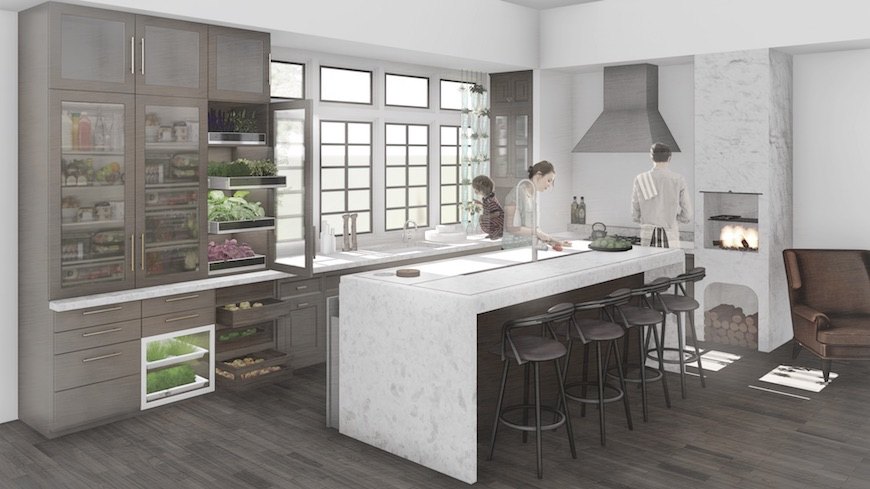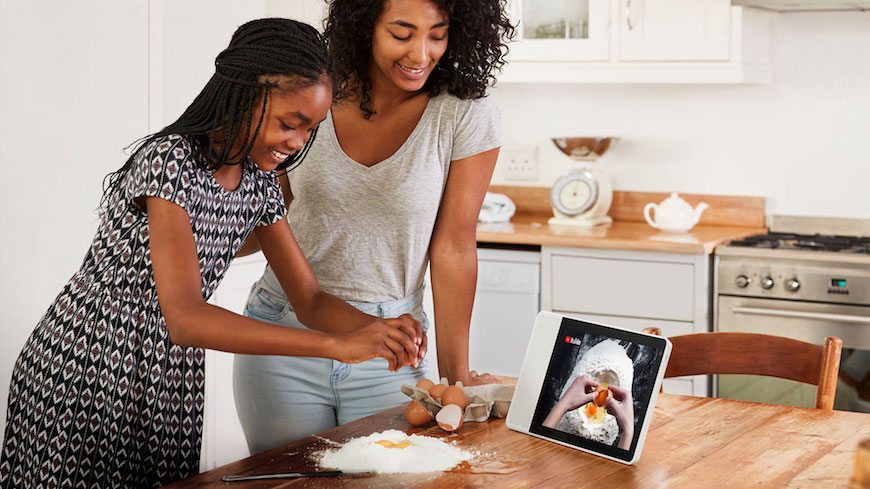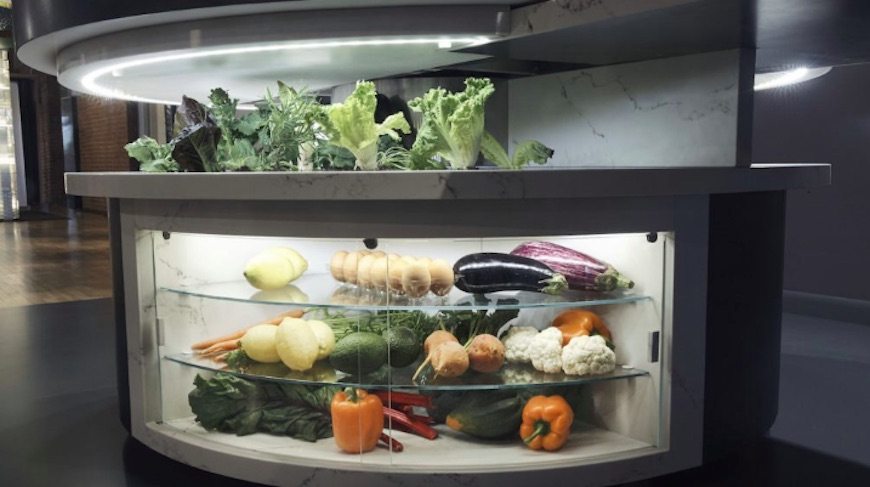The Plus Factor: How Kitchens Are (Finally) Getting the Wellness Makeover Healthy Eaters Deserve
This week on The Plus Factor, we’re talking about how kitchens are undergoing their biggest makeovers yet. From virtual sous chefs to appliances that know what food you have at home better than you do, wellness is front and center of this home model moment. And you thought a toaster oven was clever, right?
These days, the average grocery store loot is centered around fresh produce, sustainably-sourced meats (and their vegan counterparts), alternative milks, and of course, lots of healthy snacks. TV dinners, canned goods, and processed foods are starting to take up less valued real estate at home. Not that you would be able to tell by looking at the average kitchen.
For some reason, while the rest of the house is being outfitted with mounted TVs, wireless speakers, and mattresses that track how well you sleep, the kitchen has remained largely unchanged. Sure, they may be bigger and come with islands now, but fridges, ovens, trash cans, and even cabinetry has remained pretty much the same. Well, until now.
Architects and tech inventors have caught on that this whole eating healthy thing isn't just a passing fad and are giving it their full attention. Their upgrades are true reflections of what consumers want, which is easier ways to eat nourishing foods. Oh, and to be entertained at the same time because everyone knows the kitchen is the busiest part of any home.

{{post.sponsorText}}
Here, industry leaders from Google, Amazon, Samsung, and more—as well as a wellness architect—reveal the latest and greatest ways the kitchen is (finally) getting a healthy makeover. Plus, what it will look like 10 years from now.
Keep reading to see how kitchens are getting the wellness makeover to fit your healthy life.

Designing with wellness in mind
"I've been really frustrated that the majority of convenient products we have in our kitchen were created in the 1950s. That's when women were going into the workforce for the first time, leading to the debut of microwaves and processed foods," says wellness architect Veronica Schreibeis Smith.
"They were really cool inventions, but nobody knew that everything from the packaging to the actual food would slowly kill our entire society, making us more obese and cause disease. How can we reimagine the kitchen that makes it more convenient to not only eat right but to dispose of it?" It's a question she asks herself regularly while designing kitchens for private homeowners, as well as resorts and spas. Smith describes wellness architecture as certain ways designers might shift a person's behavior, encouraging them to make healthier decisions. It affects everything from the layout, cabinet structure, and even the materials.
"Our bodies respond differently to synthetic materials than to materials from the earth," she says, on why she uses marble, wood, and other natural substances over plastic. "Synthetic material puts the body in a very subtle fight-or-flight response," she believes. "Even if you paint plastic to make it look like wood, your body will notice the difference."
"The majority of convenient products we have in our kitchen were created in the 1950s." — Veronica Schreibeis Smith, wellness architect
It's the reason why the first makeover she typically gives to kitchens is with cabinetry. "One idea behind the wellness kitchen is to install cabinets that have the ability to change temperature and humidity through glass and lighting," she says. Instead of cabinets being used to store cans and boxed foods, she sees them as space for more living foods, ensuring they stay alive longer. And she wants it to be visible and reachable too. Instead of unhealthy food hiding behind dark doors, she wants people in the kitchen to be seduced by all the healthy fruits and veggies within reach.
She's not the only designer who wants to devote more kitchen space to preserving fruits and vegetables—and even growing it. Industrial design students at the Pratt Institute recently teamed up with architect Marc Thorpe to reimagine the kitchen and their end model was centered around spotlighting produce at home. It's a desire shared by tech leaders across the board as well.

Photo: Google
Letting your virtual sous chef show you how to cook
While still not necessarily a staple, having an Amazon Echo or Google Assistant is pretty common at this point. Some families even have more than one, placing them in various rooms of the house. As talking to technology has become, well, less weird, it's evolved into a sous chef of sorts in the kitchen.
"One of the most common ways people use Google Assistant in the kitchen is by asking for healthier substitutions." —Lilian Rincon, director of Google Assistant
"We see people using Alexa to set timers, convert measurements, and ask questions, such as how long they should bake chicken for," says Paul Cousineau, the director of Alexa Household Organization at Amazon. Lilian Rincon, director of Google Assistant, is seeing similar habits and she says we're the healthier for it too. "One of the most common ways people use Google Assistant in the kitchen is by asking for healthier substitutions," she says.
Having your virtual assistant relay recipe steps to you and tell you when your vegan mac-and-cheese is done is one thing, but earlier this summer, Google unveiled the first visual virtual assistant, the Lenovo Smart Display, and Rincon says it'll make healthy cooking even easier. "Now, you'll be able to see the steps of a recipe, which can be activated by voice or touch," she says. It's also compatible with YouTube, so if you ask it how to do something, like how to cut an avocado, it will pull up a video and show you how.

Upgraded appliances
While virtual assistants are being used more throughout the home—the kitchen included—the appliances that anchor the room are by no means getting left behind. You could choose to do the bulk of your cooking with Brava, the world's fastest oven (now available for pre-order), which uses pure light instead of heat. Not only can it cook your entire meal all on the same plate and at the same time (even if they all require different temperatures), it also has an app so you can literally watch your food cook on your phone. Not to mention its recipe index and meal delivery service.
Then there's June Oven, a smart oven that promises precision-timed cooking. "It uses sensors and artificial intelligence to recognize, monitor, and cook food to users’ preferences, while the software-controlled heating and convection design delivers precise cooking results,” says founder and CTO Nikhil Bhogal. “Unlike traditional appliances, the June Oven is constantly getting better; frequent software updates add new cooking abilities and cook-programs based on chef development and user feedback and preferences.”
"People spend 60 percent of their waking time in the kitchen and their homes are a reflection of their lifestyle." —Claudia Santos, Samsung's marketing director.
Even the fridge is getting the tech treatment. Samsung doesn't even call their latest fridge a fridge. It's an, ahem, family hub. That's because there's an entire entertainment system built in there that plays music and videos. "People spend 60 percent of their waking time in the kitchen and their homes are a reflection of their lifestyle," says Claudia Santos, the brand's marketing director. "This year, we've made the refrigerator a hub for your connected life by integrating features like Bixby intelligent assistant and will be adding our SmartThings dashboard to the fridge. You can check if your lights are off and the doors are locked at the end of the night, peek in on the baby in the next room, even see who is at the front door—all from the front of the fridge, thanks to the app."
And as for the actual, you know, food part, there's smart features there, too. The inside of the fridge is outfitted with cameras that connect to your phone, so if you're at the grocery store and want to check to see if you're out of something, you can. There's also a meal planning app that helps you figure out what you can make based on what foods you already have.

What's next?
If all of this is a reflection of where we are now, it can be overwhelming to think about what the kitchen will look like more in the future, say, in 10 years. Santos thinks by then everything will be totally streamlined. You'll buy a house and not have to worry about figuring out all the tech stuff.
Rincon, at Google agrees. She also has a hunch that the smart assistants available now will be even more personalized. "This is a really big priority for us," she says. "In the future, I could see your Google Assistant knowing what you shopped for over the weekend and that you cook on Monday nights and will be able to suggest meal ideas for your family. Or, it'll know you workout on Tuesdays and Thursdays, so that will affect what you eat. When it comes to health and wellness, there is so much it can learn. All of this is just the beginning and we're on the cusp of so many exciting things."
Smith is hoping one mainstay in the kitchen will be completely revamped: the trashcan. "I hope the trash compactor becomes obsolete," she says. "I hate the idea of compacting garbage and waste just to fit more into a landfill." Instead, she's looking to work with someone to create an appliance that will replace it. "It would be the size of a trash compactor that opens up to the top of the counter. That way, it's really easy to squeeze any extra produce waste into it. Then, it would compact, grind, and freeze it for you so there would be no smell issues." Then, the homeowner could take its contents to a local composting station.
It's clear that every single part of the kitchen has the potential to be revamped in a way that fits a healthier, more personalized, and environmentally-friendly lifestyle. It hasn't gotten this much attention since, well, ever. The kitchen is still going to be the main hub of the house. And it's gunning to be the healthiest room, too.
If you're all about that healthy tech life, check out these sleep-optimizing products. Or, go retro with these old-school tech pieces.
Loading More Posts...